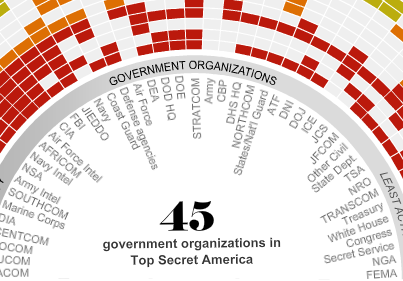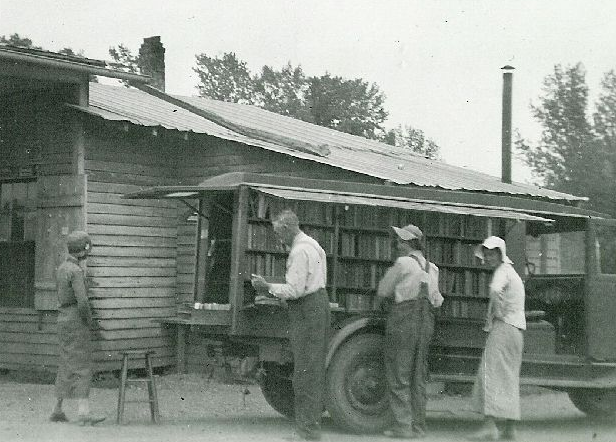The New Nightmarish, Hypnotic Quiznos Screeching Cats Ad
“A press release points out that the tabbies are intended as ‘fun and humorous,’ which is helpful, because there’s no way of telling that by actually watching.” N.B. “not by Joel Veitch,” inventor of spongemonkeys.
The Intelligence Edifice: Too Big To Succeed
The Intelligence Edifice: Too Big To Succeed

A tantalizing Twitter from @Wikileaks went up on Saturday morning: “Real change begins Monday in the WashPost. By the years end, a reformation. Lights on. Rats out.”
The series to which they referred, “Top Secret America,” by Dana Priest and William Arkin, began today and is certainly a barn-burner. It features an enormous database detailing the thousands of complex connections between private business and the evidently-misnamed intelligence community. The story has been tearing up the Internets all day long, even though Priest and Arkin don’t really reveal much that we didn’t already know, or at least that we didn’t suspect: the government is a mess! 9/11 persuaded everyone that we ought to throw every available dollar into “fighting” the “terrorists,” which somehow translates into reading everyone’s email and forcing you to pour shampoo into tiny bottles every time you want to get on an airplane!
Ka-ching for “security” companies all round, as every bit of information that can be vacuumed up is recorded eight times and then dumped into a dozen different computer systems that can’t talk to each other! The government’s secret intelligence-gathering has cratered into a bottomless pit of wasteful, pointless, expensive makework that is not making Americans any safer, but is instead reaping huge profits for the herds of greedy contractors who aid them in recording so much information that nobody will ever in a million years find the few bits that might ever have been of any use.
And we kind of knew this part, too, but the scale of the intelligence ramp-up in the last decade really is astounding:
The Pentagon’s Defense Intelligence Agency, for example, has gone from 7,500 employees in 2002 to 16,500 today. The budget of the National Security Agency, which conducts electronic eavesdropping, doubled. Thirty-five FBI Joint Terrorism Task Forces became 106. It was phenomenal growth that began almost as soon as the Sept. 11 attacks ended.
It’s the detail that clinches the deal, here. The amount of work that went into the preparation of the story is monumental. A volvelle-like chart breaks out the top-secret work done by each agency; the searchable database names nearly 2,000 companies involved in top-secret work, and furnishes the locations of over 10,000 locations all over the country where such work is performed. My favorite one is this!
In Elkridge, Md., a clandestine program hides in a tall concrete structure fitted with false windows to look like a normal office building.
Someone please explain this to me. It’s an office building cleverly designed to look like an office building? It’s that there are no real windows, I suppose, so that Jason Bourne won’t be able to get a look in.
Emptywheel and Rayne over at Firedoglake have already got spectacular analysis of Top Secret America.
I’ve got a ton of respect for Priest’s reporting and therefore would guess that the article is designed to reveal the truth about the IC and DoD. And yet the intelligence community, inside its bunker, perceives a search for the truth as a design to portray it unfavorably.
What an apt explanation, then, for the problem with excessive contracting: when a reporter avails herself of Constitutionally protected rights to act as a watchdog on our government and its contractors, the government itself assumes that must be an attack. Hell, the IC has had time to preemptively respond to some of the problems Priest is about to reveal (and, as I said, Shorrock gave them a head start two years ago). [That would be Tim Shorrock, author of Spies for Hire.]
But note, too, that the military itself has had ample time and opportunity to deal with the issue of scale. Recall that last November the House Oversight Committee requested a head count of contractors and subcontractors from Defense Secretary Robert Gates, giving him 30 days to provide the numbers.
It does not appear that this information has yet been furnished, nearly eight months later. If it has, it’s not been widely reported. And we already knew that there were extremely large variances between contractor numbers reported by different groups.
The situation makes for a lot of interesting questions:
o Why is ODNI squirming about revelations from WaPo’s Priest, but not the Pentagon?
o Why aren’t the contractor/subcontractor numbers being disseminated widely?
o How many of the intelligence contractors aren’t actually contracted by CIA but by DIA?
o Just how many of these intelligence contractors are not only working in Iraq and Afghanistan, but in places the American public at large doesn’t think of as threats — like Central and South America?
o And how many of them are in Pakistan — intel or military — in which local sources report a very large complex rivaling the U.S. embassy in Baghdad is being built and guarded by private security contractors?
I’ve got two questions myself. One is, what was the exact role of Wikileaks, if any, in helping the Post reporters gather their material? Their coy Saturday tweet wasn’t the first word on Priest’s project; Marc Ambinder, The Raw Story and others noted on Friday the panic among intelligence officials rising in advance of Monday’s Post. But I’ve noticed that @Wikileaks doesn’t seem to comment much on stories they’ve not been involved in themselves.
My second question is, will the rats really leave, just because someone turned the lights on? Seriously, how are they to be removed? I hope that prediction is accurate, but these aren’t ordinary rats, one feels compelled to observe. These are like, rats with billion-dollar defense contracts. Rats at an infinite trough of hot bread that just keeps right on comin’.
Maria Bustillos is the author of Dorkismo: The Macho of the Dork and
Kansas City Awl Commenter Party!

The Kansas City Awl-Commenter Shindig is this week! Yes. IN AMERICA’S HEARTLAND. Right next to its breadbasket and up from its armpit. It’s this Thursday, July 22nd, 7:00 p.m., at Dave’s Stagecoach in Westport. Your hosts petejayhawk and Art Yucko will be there. Possibly on their own.
A Note On The Weather

I woke up early this morning and dressed in the dark, which resulted in my leaving the house in a pair of khakis and a green polo. Green-on-green is an absolutely ridiculous look, but those of you who know me know that I’m not particularly obsessed with the condition of my wardrobe. (Plus, when you’ve got a face like this, the packaging is completely irrelevant.) I only mention this to note that when I hit the streets for my most recent cigarette (which was delightful, by the way; those of you who have cut back on smoking during the summer months should really reconsider) I happened to notice that it was a bit unpleasant, temperature-wise. I mean, it is rather vexatious what with the heat. A RealFeel of 101? It’s extremely uncomfortable, I tells ya! My balls are all, “It’s as hot as us!” We’re talking about what Sarah Palin would no doubt refer to as “hotnessitude.” And it doesn’t look like it’s going to get much better for the rest of the week. So make sure you’re drinking a lot of fluids and staying indoors as much as possible. Because, no, I’m not granting any dispensations on shorts. You’ve had it too easy already this summer. It’s time to grow a pair, and then have that pair sweat profusely through your slacks, goddamn it. I am, however, declaring socks optional through Friday. You’re welcome.
Books for the 'Inception' Enthusiast
“I loved Inception. Can you recommend any books that would be similar?” There are some good recommendations: Greg Bear’s Queen of Angels, Iain Banks’ Transition, Mark Z. Danielewski’s House of Leaves; your mileage may vary.
New Soda Beverage Made of Chili is Hot

I’m sorry but have you guys tried these “Prometheus Springs” semi-soda things? They are “the world’s first capsaicin spiced elixir.” I tried the “lychee-wasabi” one and the “pomegranate-black pepper” one, because I am gay and therefore drawn to new product rollouts. Guess what? IT BURNS. Is this the future of beverages? The burning? The burning becomes somewhat pleasurable after a bit. In other news, capsaicin (8-methyl-N-vanillyl-6-nonenamide!) either causes or prevents tumors or does neither of those. PLEASE REPORT BACK.
Booktorrent! The Bookmobile as Rural Filesharing Network
by Jane Hu

In the 1908 booklet Books for the People, the Midwestern librarian Henry E. Legler wrote: “Following in the wake of the great public library movement, which in less than two decades has dotted the cities of the United States with buildings that house millions of books for the people, came systems of traveling libraries.”
Legler was speaking of what we call bookmobiles, which began to connect the rural cities of America during the early twentieth century.

Since its development in the mid-nineteenth century, the American public library stood not only as a resource for books but also as an institution which mediated between a community and its knowledge. As they gained in popularity, libraries made edified and edifying conversations a part of daily American life.
Not merely a response to the needs of cities, the public library was partly a self-driven and active commitment to cultivate intellectually stimulated communities. There’s more than one way to look at that. In his lecture “Cultural Institutions and American Modernization,” Neil Harris proposes that the development of libraries in the late nineteenth century was “one of the movements of urban reform…[which] sought to impose the cultural and social norms of the upper class.”
Rural populations remained for the most part excluded. Too small to sustain local libraries, villages and towns could not access the same materials as metropolitans. The answer to this conundrum? Bookmobiles! Like the public library a century before, the bookmobile strove not only to deliver books, but also to develop an intellectual environment for its patrons.
The first American bookmobile came in 1905 when the head librarian of Washington County Free Library, Mary Titcomb, pioneered the mobile distribution of books across the county. With library janitor Joshua Thomas steering the horse-drawn wagon, Titcomb delivered boxes of books to “deposit stations”-the general stores and post offices of small towns.
Even before Titcomb began her delivery services, the response to this “first buggy book wagon” was met with positive cries: “Libraries to the people!” From then on, the popularity of the library wagon rose: boxes of 30 volumes each were sent to 66 deposit stations throughout Washington County. By 1912, automobiles replaced the original horse-drawn carriage. Without the physical limitations of animal-powered transportation, these vehicles carried even larger collections than before.
In his book Library Ideals, Legler describes how some of the earliest bookmobile were maintained:

Not everyone supported the passage of texts into small towns. Over in England, as early as 1825, Blackwood’s Magazine published an article that claimed, “Whenever a lower order of any state have any smattering of knowledge they have generally used it to produce national ruin.” It seems the political menace of placing a text in the “wrong” hands has always paid books the compliment of their influential force.
Rural librarian Patricia Salau lauded the cultural possibilities of bookmobiles:
Country people do not have other access to library materials…Frequently, their occupations do not encourage a cultural inclination, or an attitude of self-education…The bookmobile has to show country people that it is available for a range of topics beyond recreational reading, and further, it has to show them that it is useful to learn by reading and discussion, and to consider topics which don’t normally arise in their pastoral or small-town undertakings.
Despite the somewhat demeaning connotations of Salau’s description of “pastoral” or “country people,” her intentions are downright noble.
There was, of course, “good” reading and “bad” reading. One study of the time worried over farmers, who seemed to read only “bulletins and journals of agricultural practices,” while another warned against “penny dreadfuls,” which threatened “the youth of to-day, whose literary excursions will take him into the company of ‘Buster Brown’ and ‘Happy Hooligan,’ will have an even chance with the youth of a generation ago to develop into a useful and law abiding citizen?” Hey! I never realized how old this debate was either.
The influential public librarian Eleanor Frances Brown notes that although earlier bookmobiles were filled with “westerns, mysteries, light love stories, general fiction, a smattering of not-too-deep non-fiction, and a great amount of children’s material,” they progressively accrued intellectual texts of “abstract art” and “literary criticism.” She writes in Bookmobiles and Bookmobile Service (1967) that, by the 1960s, “there was little, if any, interest in the light and inconsequential.”
With the rise of bookmobiles, texts were accessible to an older generation who had never encountered libraries or any concept of information repositories. In one case, a….
woman sixty years old walked three miles over ploughed fields to get books, reading ‘Little Women,’ ‘Lorna Doone,’ and ‘The Vicar of Wakefield’ for the first time, catching up on all the reading she hadn’t had time to do in the first half century of her life.
The bookmobile also provided often-detached rural populations opportunities to socialize. In attempts to appeal to adults, bookmobiles often added late night stops. (I’m a little disappointed these don’t happen anymore.) The goal of the bookmobile to educate and thus “make better Americans” opened up a cultural conversation that spreads each day with the traveling word.
When I was growing up, my local public library would give out covers to hold our library cards. In one pocket, you would place your library card, and in the other, your bus pass. On the front, a happy slogan read: “All roads lead to the library.” Wouldn’t it be cool if the road was the library?
Pictured above: an early Davidson County, Tennessee, bookmobile; that county bookmobile service began in 1929.
Tree Smells Like Come

“When it comes to the tree of heaven, Lorraine Johnson doesn’t beat around the bush. ‘There’s no doubt,’ says the author and native plant expert. ‘It smells like semen.’”
–This article discusses Ailanthus altissima, also known as “sperm tree, semen tree, ghetto palm, stink tree,” jizz timber, spunk sapling, splooge blossom and ejaculate conifer. (I may have made a couple of those up, see if you can guess which.) Anyway, now you know.
Who Makes The Deficits
One gets exhausted simply sorting through the lies and distortions concerning the deficit and who deserves blame, but it’s important to keep these things straight. Here’s Ezra Klein on the expiration of the Bush tax cuts: “It’s not a tax increase passed into law by Democrats. It’s a reversion to old tax rates passed into law by Republicans. It’s not how law is supposed to work. It’s the result of twisting a budget process meant to reduce the deficit so you could use it to massively increase the deficit. And as for the policy itself, it’s a fiscal nightmare: No one who professes concern for short-term deficits can argue for the extension of these deficit-financed tax cuts and retain credibility on debt issues. This is a litmus test. It’s not Democrats who are trying to pass the largest tax hike of all time, but Republicans who are calling for the largest increase in the deficit in memory.”
